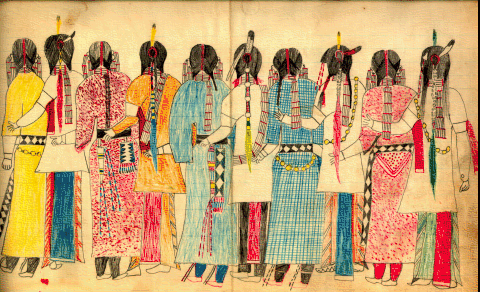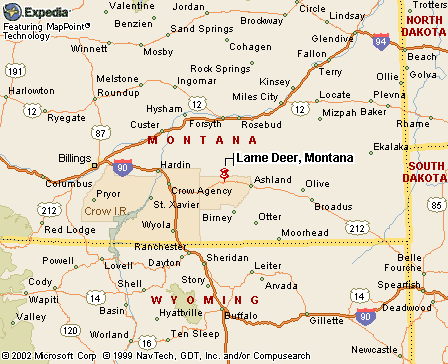|

An ancient Cheyenne prophet said his people’s end time would arrive when they stopped
speaking their language.
Sweet Medicine’s words seemed to loom larger with each new generation of Northern Cheyenne.
But a century-long erosion of the tribe’s tongue is beginning to slow, thanks to a recently developed language
teacher certification program at Chief Dull Knife College in Lame Deer. In the last four years, the number of certified
language instructors has nearly doubled to 13, said college President Richard Littlebear.
“Our language was taken away from us, but we are desperately hanging on to it,” said Littlebear, who holds a doctorate
in education. “Once you lose a language, you lose a culture. Language transmits culture. It forms the basis for
identity.”
Using a grant from the W.K. Kellogg Foundation, Chief Dull Knife College developed a language education curriculum
Littlebear believes will help the tribe keep its language alive.
To gain state certification, the potential instructors must prove their skill in English and Cheyenne.
The students must speak fluently and translate a text from English to Cheyenne without using a word of English.
Cheyenne is an ancient language and the students must improvise when modern words are encountered. Diabetes, for
example, is called “the sugar sickness” using Cheyenne nouns. The potential instructors are also given lessons
on teaching methods.
“We recognize that fluency does not make you a teacher,” Littlebear said.
Since 1996, Montana has been one of the few states that has a teacher certification classification for Indian languages,
Littlebear said. The certification has caused grumbling among some teachers with four-year degrees – language instructors
do not necessarily need a bachelor’s degree – but Littlebear said the special status is needed because the instructors
are often the only repository of their tribe’s language.
“At no other place in the world is Assiniboine or Sioux or Gros Ventre or Cheyenne taught. You can’t find this
at Yale or Harvard,” he said. “Many of the (certified teachers) have near-Ph.D. knowledge of their own language
and culture.”
Montana’s universities are also among the few in the nation that give foreign language credit for Indian languages.
This is an added incentive for Northern Cheyenne students who increasingly have the opportunity to learn the Cheyenne
language at schools across the reservation, Littlebear said.
About 40 percent of Northern Cheyenne speak their language, Littlebear said. Many elders, including Littlebear,
grew up with Cheyenne as their first language, but were not allowed to speak the language at school. The United
States government has dropped its ban on native languages, but popular culture is proving more destructive.
The threat of losing the language was even more real because Cheyenne was not a written language until the last
century, when linguists adapted the oral sounds to the English alphabet. This meant that when storytellers died,
pieces of the culture were buried with them.
Until recently, only five people could read and write the language. The number has doubled in the last six years,
Littlebear said.
Littlebear, who is 61, didn’t begin learning to write and read in his own language until he was 40.
“I thought ‘Why should I always be reading and writing in a language that is killing my own?’” he said.
Littlebear said the culmination of his “very personal journey” came five years later when he was to able read the
23rd Psalm of the Bible in his native tongue. The passage has long been a favorite, he said.
“It’s poetic and melodious, written by people who love language,” he said. “When I learned how to read it in Cheyenne,
it just blew me away. It was even more poetic and evocative.
“It’s soul-satisfying to be able to read and speak your own language.”
Although there are more language instructors, additional work is needed to counter myths about learning Cheyenne,
Littlebear said. Some say Cheyenne is impossible for outsiders to learn, or it can only be soaked up by the malleable
minds of youth.
“Cheyenne isn’t any harder to learn than any other language,” Littlebear insisted, adding that adults often find
it easier to learn a second language because they have already mastered one tongue.
Non-Cheyenne also do well at learning the language – immersion instruction camps are offered every summer in Lame
Deer.
“White speakers are socialized differently, they’re supposed to talk out in classes and be more vocal,” Littlebear
said. “That makes for a very good language student. You can’t learn language in silence.”
Cheyenne language instruction concentrates on oral practice. The language is full of complicated sounds, including
silent vowels, “tsk” sounds and glottal stops (such as saying “uh-uh”). Words are often constructed by stringing
together strings of verbs and suffixes.
“Sometimes the words are really long,” Littlebear said.
According to a Cheyenne language Web site, one of the longest words is: “náohkêsáa'oné'seómepêhévetsêhésto'anéhe,”
which translates to “I truly do not pronounce Cheyenne well.”
Language students must learn to laugh at themselves, Littlebear said. The Cheyenne are masterful jokesters with
their language, but they are also honored by people who attempt their ancient tongue.
“Whenever a Cheyenne speaks Cheyenne, there’s always laughter,” Littlebear said. “We love manipulating the Cheyenne
language to make it funny. We love talking Cheyenne.”
Littlebear said he hopes the language certification program at Chief Dull Knife College will keep his people talking
and laughing in their ancient tongue for years to come. “My vision is that the Cheyenne language will be spoken
forever.”
For more information and to see a list of Cheyenne words, visit: www.geocities.com/cheyenne_language/
|


